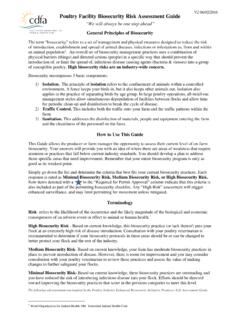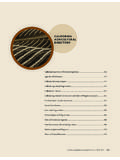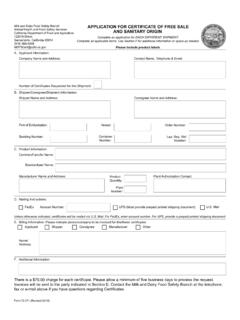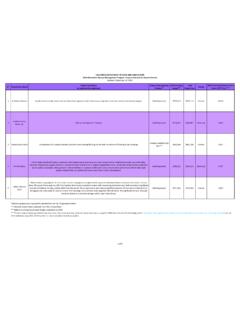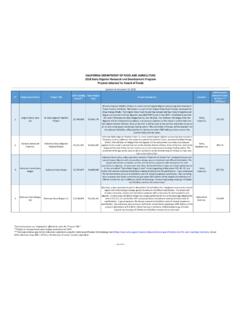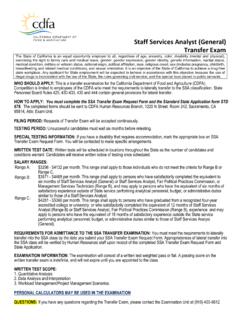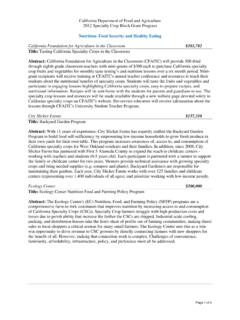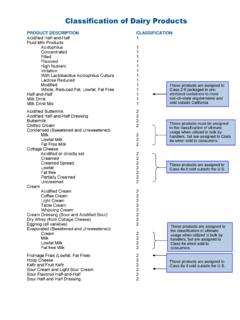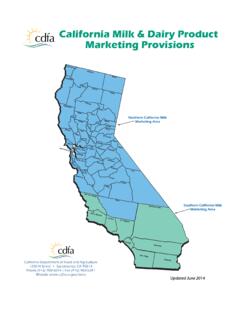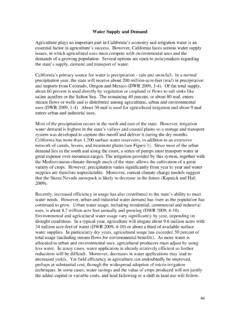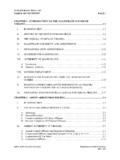Transcription of Table of contents Introduction - California Department of ...
1 Introduction ince the fall of 2005, swine practitioners in the United States have been reporting increased numbers of cases of postweaning multisystemic wasting syndrome (or PMWS) in finisher pigs. In contrast to previous reports of PMWS in the United States, this form of the disease has been more severe, with pigs experiencing rapid weight loss and higher rates of mortality. Research trials and field cases have shown that porcine circovirus type 2 (or PCV2) plays a role in the presentation of PMWS.
2 The role of other infectious and non-infectious agents has yet to be determined. The National Pork Board, through the Pork Checkoff and the American Association of Swine Veterinarians have recognized the importance of this syndrome to our industry and have taken several actions. The Pork Checkoff has committed over $500,000 in funding toward research on PMWS and PCV2 associated diseases, $200,000 in cooperative funding with USDA, and prepared producer-directed awareness and informational material on the same topics.
3 In March, the American Association of Swine Veterinarians (AASV) formed the PCV2 Ad Hoc Committee. One of the recommendations made by this committee has been to develop a name that encompasses several syndromes including postweaning multisystemic wasting syndrome (or PMWS). The name suggested by AASV is porcine circovirus associated diseases (or PCVAD). PCVAD will be used to describe the different diseases attributed to porcine circovirus. This brochure uses the new denomination (PCVAD) throughout. In 1996, Dr.
4 Francois Madec recommended 20 management practices to reduce the effects of PMWS. These principles have been utilized by practitioners around the world to reduce the losses associated with this disease. The Madec principles , as they are termed, are used as the basis for some of the recommendations included in this brochure. Other research findings are also included in this text. This brochure is a joint effort between the AASV and the Pork Checkoff. Its goal is to offer recommendations that may help to reduce the economic effects of PCVAD.
5 Remember to consult with your herd veterinarian to confirm a diagnosis of PCVAD and for information on how the information in this brochure can be applied in your of contentsIntroduction ..1 Disease description ..2 What will the veterinarian do? ..4 The need for laboratory diagnosis..5 What can you do if PCVAD is diagnosed on your farm? ..5 Farrowing Barn .. 6 Nursery Facilities .. 8 Grow-Finish and Finisher Facilities .. 10 Replacement Stock .. 12 Others .. 14 What other practices may your veterinarian recommend?
6 15 Twenty Technical Recommendations..16 References..17S1 Disease description Most PCVAD affect pigs in the early finisher phase. Finisher farms affected by PCVAD have reported one, some, or all of the following signs: Anorexia Rapid weight loss Unthrifty pigs Skin discoloration Respiratory signs Diarrhea Symptoms, duration and mortality can vary by herd, group, barn or site. It is important to note, however, that within herds or groups, some PCV2-positive pigs may be asymptomatic and not express any kind of PCVAD.
7 PCV2 is endemic worldwide and experts believe that there are no PCV2-negative swine herds. However, a herd that is positive to PCV2 will not necessarily experience PCVAD. This form of PCVAD is usually accompanied by a variety of concurrent viral or bacterial infections. The Pork Checkoff completed a PCVAD surveillance project in 2004. It found concurrent infections with the porcine reproductive and respiratory syndrome (PRRS) virus, Mycoplasma hyopneumoniae or the swine influenza virus in 95 percent of submissions of animals presenting clinical signs and confirmed positive to the presence of PCVAD through laboratory testing.
8 The same project also found the presence of bacteria such as Pasteurella multocida, Streptococcus suis and Salmonella sp., in PCVAD positive presentation of PCVAD also could be related to the presence of environmental stressors. Anecdotal reports include out-of-feed events as a precursor to the presentation of the diseases. Other environmental stressors may include:Recent mixing /sorting of pigs High stocking density Suboptimal temperatures or ventilation The presence of concurrent infections in the herd Other management practices prior to the expected time of PCVAD need for laboratory diagnosisPigs experiencing PCVAD can have clinical signs which can be mistaken for many other diseases, especially because coinfections are common.
9 It is critical for the herd veterinarian to examine the animals in their environment and perform necropsy on sick pigs. The herd veterinarian will collect samples from numerous organs and from several animals to send to a diagnostic laboratory. To confirm PCVAD, porcine circovirus type 2 has to be identified in the tissues and associated with damage found in these tissues. The laboratory will also identify existing coinfections. What can you do if PCVAD is diagnosed on your farm?If PCVAD is diagnosed on your farm, follow the herd veterinarian s advice.
10 Veterinarians may include some or all of the practices detailed on the following pages. These are presented by production phase and further categorized as biosecurity practices, production and management practices, environmental management practices and health practices. What will the veterinarian do?If PCVAD is suspected on the farm, contact the herd veterinarian immediately. Because of the variability in signs and severity, the veterinarian may want to examine the herd, perform several necropsies and submit good quality samples to a laboratory to confirm the InspectionNecropsySamples for Laboratory Diagnosis54 BiosecurityEmpty, clean and disinfect between groups.
